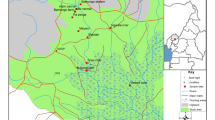Abstract
Deterministic and probabilistic risk analyses were carried out for seven hydrographic basins in the State of Santa Catarina (Brazil), where irrigated rice is cultivated. Monitoring studies conducted in 1998/1999 and 1999/2000 had found that the herbicide quinclorac was the most frequently detected agrochemical residue, occurring in five of the seven hydrographic basins. In order to assess the ecological risk posed by quinclorac, median lethal concentration (LC50) and median effective concentration (EC50) data were obtained for quinclorac in toxicity tests with organisms routinely used in Brazil for this purpose. Experiments were carried out on microcosms associated with the irrigated rice crop to evaluate the effects of the herbicide on the natural plankton community. The deterministic analyses showed that the risk presented by the herbicide residues to the phytoplankton require mitigating action, while the probabilistic analysis revealed that the levels of risk for the aquatic community were acceptable. Field experiments showed that the recommended application concentration of the product directly affects phytoplankton and has an indirect, short-term effect on the zooplankton community.





Similar content being viewed by others
References
Barry MJ, Logan DC (1998) The use of temporary pond microcosms for aquatic toxicity testing: direct and indirect effect of endosulfan on community structure. Aquat Toxic 41:101–124
Boltovskoy D (1981) Recuento y análisis de los dados. In: Boltovskoy D (Ed) Atlas del zooplâncton del Atlantico Sudoocidental y métodos de trabajo com el zooplancton marinho. INIDEP, Mar del Plata, pp 153–168
CETESB (1992a) Teste de toxicidade crônica de curta duração com Lytechinus variegatus Lamarck, 1816. Norma Técnica, São Paulo
CETESB (1992b) Teste de toxicidade aguda com Mysidopsis juniae Silva, 1979. Norma Técnica, São Paulo
Empresa de Pesquisa Agropecuária e Extensão Rural de Santa Catarina (EPAGRI) (2005) Sistema de produção de arroz irrigado em Santa Catarina (pré-geminado). 2 edn. Florianópolis. Epagri. Sistema de Produção, 32
Deschamps FC, Noldin, JA, Eberhardt DS, Hermes LC, Knoblauch, R (2003) Resíduos de agroquímicos em água nas áreas de arroz irrigado em Santa Catarina. In: Proc 3rd Congr Brasileiro de Arroz Irrigado e XXV Reunião da Cultura do Arroz Irrigado. Balneário Camboriú, Brazi, pp 683–685. Available at: http://www.sosbai.com.br
Hanazato T (2001) Pesticide effects on freshwater zooplankton: an ecological perspective. Environ Pollut 112:1–10
International Organization for Standardization (1989) ISO 8692: Water quality – fresh water algal growth inhibition test with Scenedesmus subspicatus and Selenastrum capricornutum. ISO, Geneve, Switzerland, pp 11–15
Jost GF (2003) Avaliação dos impactos de agrotóxicos sobre copépodas (Crustacea: Copepoda) presentes na água de irrigação da cultura de arroz irrigado. Monograph, UNIVALI, Itajaí, Brazil
Miron DS, Silva LVF, Golombieski JI, Machado SLO, Marchezan E, Baldisserotto B (2004) Lethal concentration of clomazone, metsulfuron-metil, and quinclorac for silver catfish, Rhamdia quelen, fingerlings. Cienc Rural 34:1465–1469
Munn MD, Gilliom RJ (2001) Pesticide toxicity index for freshwater aquatic organisms. US Geological Survey, Water-Resources Investigations Report 01–4077, Sacramento, CA
Nakagome FK (2004) Toxicidade aguda de alguns dos principais herbicidas e inseticidas utilizados na lavoura do arroz irrigado sobre o cladócera Daphnia magna e sobre o peixe Danio rerio. Monograph, UNIVALI, Itajaí, Brazil
Nakagome FK, Noldin JA, Resgalla C Jr (2006) Toxicidade aguda e análise de risco de herbicidas e inseticidas utilizados na lavoura do arroz irrigado sobre o cladócero Daphnia magna. Pesticidas Rev Ecotoxicol Meio Ambiente 16:93–100
Perschbacher PW, Ludwig GM, Slaton N (2002) Effects of common aerially applied rice herbicides on the plankton communities of aquaculture ponds. Aquaculture 214:241–246
Preston BL (2002) Indirect effects in aquatic ecotoxicology: implications for ecological risk assessment. Environ Manage 29:311–323
Primel EG, Zanella R, Kurz MHS, Gonçalves FF, Machado SLO, Marchezan E (2005) Poluição das águas por herbicidas utilizados no cultivo do arroz irrigado na região central do estado do Rio Grande do Sul - Predição teórica e monitoramento. Química Nova 28:605–609
Reis Filho RW, Resgalla C Jr (2002) Testes de toxicidade com embriões de Perna perna (Linnaeus, 1758) (Mollusca: Mytilidae): avaliações de indução e sensibilidade. Notas Téc FACIMAR 6:7–17
Resgalla Jr C, Noldin JA, Santos AL, Sato G, Eberhardt DS (2002) Toxicidade aguda de herbicidas e inseticida utilizados na cultura de arroz irrigado sobre juvenis de carpa (Cyprinus carpio). Pesticidas Rev Ecotoxicol Meio Ambiente, 12:59–68
Rodrigues BN, Almeida FS (2005) Guia de Herbicidas, 5 edn. Rodrigues BN, Almeida FS, Londrina, Brazil
Seus LG (2002) Toxicidade aguda e crônica em alevinos de Jundiá (Rhamdia sp) submetidos aos principais herbicidas utilizados na lavoura de arroz irrigado no RS. MSc thesis. Universidade Federal de Pelotas (UFPel), Pelotas, RS, Brazil
Sociedade Sul-Brasileira de Arroz Irrigado (SOSBAI) (2005) Arroz irrigado: recomendações técnicas da pesquisa para o sul do Brasil. Santa Maria, Sosbai
Tamanaha MS (2004) Estrutura das assembléias fitoplanctônicas e testes de inibição de crescimento algal: avaliação dos efeitos dos herbicidas e inseticidas utilizados na cultura do arroz irrigado na Região de Itajaí/SC. MSc thesis, Universidade do Vale do Itajaí (UNIVALI), Itajai, Brazil
Environmental Protection Agency (USEPA) (1999) ECOFRAM Aquatic Report, Washington D.C.
Utermöhl H (1958) Zur vervollkommung der quantitativen phytoplankton methodik. Mitt Int Ver Limnol 9:1-39
Vencill WK (2002) Herbicide handbook. Weed Science Society of America (WSSA), Lawrence, KS
Wendt-Rasch L, Friberg-Jensen U, Woin P, Christoffersen K (2003) Effects of the pyrethroid insecticide cypermethrin on a freshwater community studied under filed conditions II. Direct and indirect effects on the species composition. Aquat Toxic 63:373–389
WERF (1996) Aquatic ecological risk assessment: a multi-tiered approach. Project 91-AER-1. Alexandria, VA
Acknowledgements
The authors are thankful to Embrapa/Fundagro/Prodetab, process 77-1/98 and 1020003/0056-6, for their financial and administrative support, which made this work possible.
Author information
Authors and Affiliations
Corresponding author
Rights and permissions
About this article
Cite this article
Resgalla, C., Noldin, J.A., Tamanaha, M.S. et al. Risk analysis of herbicide quinclorac residues in irrigated rice areas, Santa Catarina, Brazil. Ecotoxicology 16, 565–571 (2007). https://doi.org/10.1007/s10646-007-0165-x
Received:
Accepted:
Published:
Issue Date:
DOI: https://doi.org/10.1007/s10646-007-0165-x




